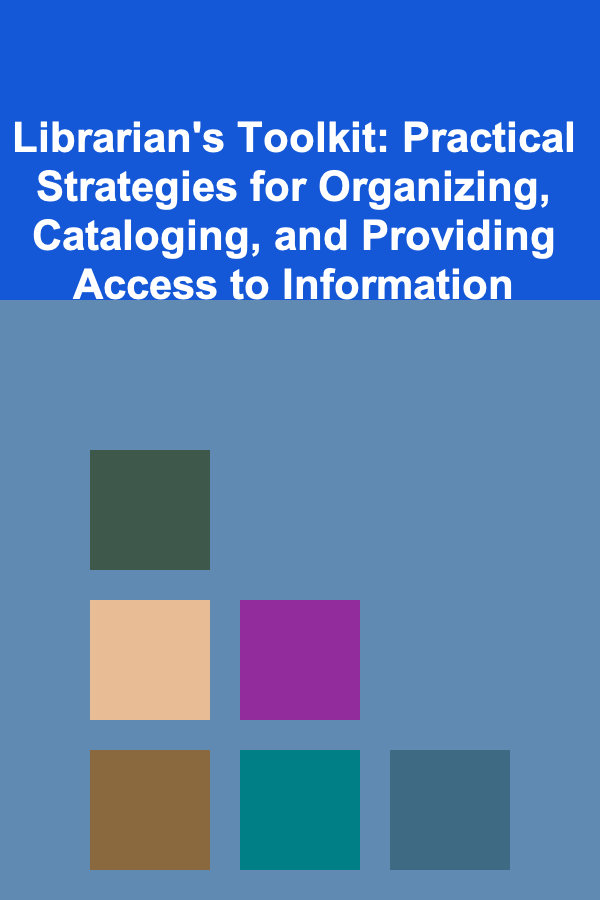
Librarian's Toolkit: Practical Strategies for Organizing, Cataloging, and Providing Access to Information
ebook include PDF & Audio bundle (Micro Guide)
$12.99$10.99
Limited Time Offer! Order within the next:

Libraries have always been centers of knowledge and information, playing a critical role in educating, informing, and inspiring communities. In the digital age, the role of librarians has expanded far beyond simple book lending to include managing vast digital collections, curating diverse resources, and providing easy access to a wealth of information. This actionable guide will explore practical strategies that librarians can implement to organize, catalog, and provide access to information in a way that meets the needs of their communities.
Organizing Library Resources: Creating a Structure for Easy Access
The first and most important task in managing a library's collection is to create a system that allows users to quickly and efficiently find the materials they need. The organization of resources can vary based on the type of materials (books, articles, digital content, etc.) and the specific needs of the library's user base. However, several fundamental principles guide effective resource organization.
1. Understanding the User Base
Before designing an organizational structure, it's critical to understand the community the library serves. The way materials are organized should align with the habits, expectations, and needs of the users.
- Conduct User Surveys and Assessments: Understanding who your patrons are and what they want from the library is essential. Surveys, feedback forms, and direct user engagement are useful tools in collecting this information.
- Segment by User Types: Different user groups (children, students, researchers, professionals, or seniors) may need different organizational schemes. Organizing resources with these segments in mind can make navigation easier for all users.
2. Establishing Logical Categories
Once you understand the community's needs, you can begin structuring the collection. Traditional Dewey Decimal or Library of Congress classifications can serve as a foundation, but there are other modern strategies worth considering.
- Create Intuitive Subject Categories: Organize the collection by genre, subject, or theme to make it easier for patrons to find materials related to their interests. For instance, instead of simply using "Science" as a broad category, it may be helpful to break it down into sub-categories like "Physics," "Biology," and "Environmental Science."
- Special Collections: For libraries with specialized resources---such as local history, rare books, or research papers---create a special collection section. These materials should be stored and categorized separately but still be integrated into the broader library system.
- Integration of Digital and Physical Resources: Libraries today often have both physical and digital collections. It's important to develop an organizational system that integrates digital content, such as e-books, databases, and multimedia materials, with physical resources for a seamless user experience.
Cataloging Library Materials: The Foundation for Information Retrieval
Effective cataloging is essential for ensuring that library resources are easy to locate and retrieve. A well-cataloged system makes it possible for library patrons to find the exact materials they need, whether in a physical library or an online catalog.
1. Adopting International Standards
Standardization is key to maintaining a consistent and accessible cataloging system. Using internationally recognized standards ensures that libraries can communicate, share resources, and streamline their cataloging processes.
- MARC (Machine-Readable Cataloging): MARC is one of the most widely adopted cataloging systems. It allows libraries to encode bibliographic data in a machine-readable format, making it easier to share and retrieve data across different library systems.
- RDA (Resource Description and Access): RDA is a newer cataloging standard designed to replace AACR2 (Anglo-American Cataloging Rules). RDA helps create more comprehensive and flexible catalog records, which is especially important in the context of digital resources.
- Dewey Decimal Classification (DDC) and Library of Congress Classification (LCC): These are the two most widely used classification systems for organizing physical library materials. DDC is common in public libraries, while LCC is used primarily in academic and research libraries.
2. Use of Metadata
Metadata plays a crucial role in the cataloging process. It refers to the information about a resource, such as its author, title, subject, publisher, publication date, and more. Proper metadata enhances searchability and retrieval.
- Detailed Metadata: Every library resource, especially digital ones, should have detailed metadata attached to it. This includes comprehensive bibliographic records, relevant keywords, and other descriptors that help users find and filter content effectively.
- Standardized Vocabulary: Use a controlled vocabulary or taxonomy to ensure consistency. This might include subject headings like "Literature" or "History," which are standard across many libraries and databases.
- Digital Resources: When cataloging digital materials such as e-books or multimedia, consider including file format, resolution, or any other technical metadata that could be useful for users or technical staff.
3. Implementing Integrated Library Systems (ILS)
An Integrated Library System (ILS) is a software solution that helps manage all aspects of library operations, including cataloging, check-outs, acquisitions, and inventory control. Adopting a modern ILS system can significantly streamline the cataloging process.
- Automation: Modern ILS platforms automate many aspects of the cataloging process, such as importing records, classifying materials, and updating inventory, making it easier to maintain a large collection.
- Open-Source ILS: Libraries on a budget might consider open-source ILS options like Koha or Evergreen. These systems offer robust cataloging capabilities without the high licensing fees associated with commercial options.
- Cloud-Based Solutions: Many ILS platforms now offer cloud-based options that allow for greater flexibility and accessibility, particularly in environments with multiple library branches or remote users.
Providing Access to Library Materials: Bridging the Gap Between Users and Information
Providing access to library resources goes beyond simply organizing and cataloging materials. It involves ensuring that users can easily find, borrow, and interact with the information they need, whether online or in-person.
1. Enhancing the Library Catalog Interface
The library catalog is the primary means through which users access resources, and it should be user-friendly, intuitive, and easy to navigate. A poorly designed catalog can frustrate users and impede their ability to find what they need.
- Search Functionality: Ensure that the search function is powerful and versatile, allowing users to filter results by various criteria such as author, subject, format, and availability.
- Mobile-Friendly Design: As more users access library catalogs from mobile devices, it's crucial that the catalog interface is responsive and works seamlessly on smartphones and tablets.
- Personalized Features: Many modern library catalogs offer personalized features, such as reading lists, saved searches, and recommendation engines, which can improve user engagement and satisfaction.
2. Integrating Digital Access
Digital resources have become an integral part of modern libraries. Patrons should be able to access e-books, journal articles, online databases, and multimedia content just as easily as physical materials.
- E-Book and Audiobook Access: Partner with services like OverDrive, Libby, or Hoopla to provide access to a wide range of e-books and audiobooks. Ensure that the process for borrowing these materials is straightforward and intuitive.
- Digital Databases: Libraries should invest in a variety of online databases (e.g., JSTOR, ProQuest, and EBSCOhost) to provide users with access to scholarly articles, journals, and research resources.
- Online Library Services: Offering virtual reference services, webinars, and digital workshops can help expand access to library resources for remote users. Chatbots, live chats, and email services can also provide quick responses to user queries.
3. Promoting Resource Access
Effective communication strategies are key to promoting library resources and ensuring they are widely used by the community.
- Marketing and Outreach: Use newsletters, social media, and events to inform the community about the availability of new resources and services. Special campaigns can highlight underutilized resources, like digital archives or special collections.
- Collaboration with Local Schools and Institutions: Libraries should build partnerships with local schools, universities, and community organizations to help raise awareness about library resources and provide easy access for students and faculty.
- Training and Support: Offering training sessions for patrons on how to navigate the catalog, use digital resources, or conduct research effectively can empower users and increase their engagement with the library's offerings.
Conclusion: The Evolving Role of the Librarian
In the modern era, librarians wear many hats: they are curators, educators, technologists, and community leaders. Organizing, cataloging, and providing access to information are the cornerstones of their work, but these tasks must be carried out with an understanding of the diverse needs of the library's users. By implementing practical strategies for cataloging, organizing, and promoting resources, librarians can ensure their collections remain accessible, relevant, and valuable to the communities they serve.
As libraries continue to adapt to the digital age, the role of the librarian will continue to evolve. However, one thing remains constant: the librarian's responsibility to ensure access to information is accessible, equitable, and meaningful for all.

How to Build an Enriching Indoor Environment for Your Pet
Read More
How to Make Money Online as a Quality Assurance Manager: 10 Actionable Ideas
Read More
How to Organize Photos from Multiple Devices Seamlessly
Read More
How to Set Up a DIY Family Bowling Alley in Your Garage
Read More
How to Use Clear Labels for All Containers
Read More
What Are the Best Organizing Methods for Small Spaces?
Read MoreOther Products

How to Build an Enriching Indoor Environment for Your Pet
Read More
How to Make Money Online as a Quality Assurance Manager: 10 Actionable Ideas
Read More
How to Organize Photos from Multiple Devices Seamlessly
Read More
How to Set Up a DIY Family Bowling Alley in Your Garage
Read More
How to Use Clear Labels for All Containers
Read More